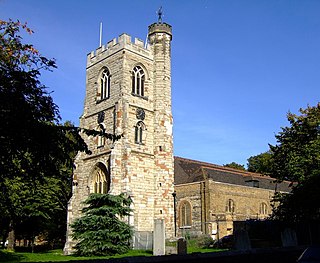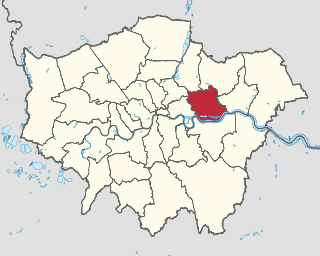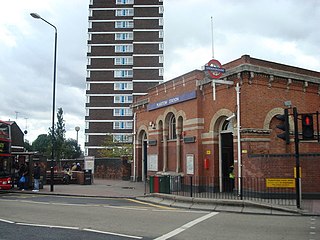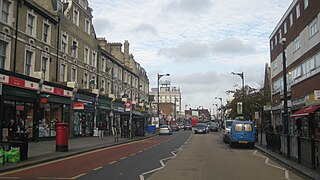
Stratford is a town in East London, England, within the ceremonial county of Greater London. Until 1965 it was within the historic county of Essex. Part of the Lower Lea Valley, Stratford is situated 6 miles (9.7 km) east-northeast of Charing Cross, and includes the localities of Maryland and East Village.

West Ham is an area in East London, located 6.1 mi (9.8 km) east of Charing Cross in the west of the modern London Borough of Newham.

The London Borough of Newham is a London borough created in 1965 by the London Government Act 1963. It covers an area previously administered by the Essex county boroughs of West Ham and East Ham, authorities that were both abolished by the same act. The name Newham reflects its creation and combines the compass points of the old borough names. Situated in the Inner London part of East London, Newham has a population of 387,576, which is the third highest of the London boroughs and also makes it the 16th most populous district in England. The local authority is Newham London Borough Council.

Plaistow is a suburban area of East London, England, within the London Borough of Newham. It adjoins Upton Park to the north, East Ham to the east, Beckton to the south, Canning Town to the south-west and West Ham to the west.

East Ham is a district of the London Borough of Newham, England, 8 miles (12.8 km) east of Charing Cross. East Ham is identified in the London Plan as a Major Centre. The population is 76,186.

Forest Gate is a district in the London Borough of Newham, East London, England. It is located 7 miles (11 km) northeast of Charing Cross.

Upton Park is an area of the East London borough of Newham, centred on Green Street which is the boundary between West Ham and East Ham. West Ham United Football Club formerly played at the Boleyn Ground, commonly known as Upton Park.

West Ham is a constituency created in 1997 and represented in the House of Commons of the UK Parliament since 2005 by Lyn Brown, a member of the Labour Party.

West Ham was a local government district in the extreme south west of Essex from 1886 to 1965, forming part of the built-up area of London, although outside the County of London. It was immediately north of the River Thames and east of the River Lea.

Green Street is a road in the London Borough of Newham, East London, which forms much of the boundary between East and West Ham.

Stratford Langthorne Abbey, or the Abbey of St Mary's, Stratford Langthorne was a Cistercian monastery founded in 1135 at Stratford Langthorne — then Essex but now Stratford in the London Borough of Newham. The Abbey, also known as West Ham Abbey as it lay in that parish, was one of the largest Cistercian abbeys in England, possessing 1,500 acres (6.07 km2) of local land, controlling over 20 manors throughout Essex. The Abbey was self-sufficient for its needs and wealthy besides; some of this wealth came from the ecclesiastic mills grinding wheat for local bakers to supply bread to the City of London. This later led to competition with the Guild of Bakers, who sought powers to levy a toll on loaves entering the City at Whitechapel.


St Andrew's Church was a Church of England church on Barking Road in Plaistow, east London. It began as a small mission built in 1860 on Whitwell Road by St Mary's Church, Plaistow. A permanent church designed by James Brooks opened in 1870 on a site just south of the northern outfall sewer embankment and a separate parish assigned to it the following year. A large central crossing tower with a pyramidal spire was planned but only completed as far as the ridge of the nave roof.
St Peter's Church was a Church of England church on Upton Lane in the Upton Cross area of Newham, East London. Its origins were in a mission of St Mary's Church, Plaistow on Pelly Road, holding services in a barn then in an iron church. Joseph Lister's former home Upton House was bought by the bishop of St Albans in 1885, becoming the vicarage, whilst its garden provided the site for a permanent church, built in 1893 and given a separate parish the following year using parts of those of All Saints, St Mary's, Emmanuel and St Stephen's. The parish was merged into that of Emmanuel in 1962 - the church was left standing as a chapel of ease to Emmanuel, but its vicarage was demolished, the site being sold in 1968. Funds from that sale and the sale of the parish hall were intended for a new church, church hall and clergy house, but in 1972 St Peter's Church was declared redundant, demolished and its site sold off, leading to the scheme's abandonment three years later.

St Matthew's Church is a Church of England church on Dyson Road in West Ham, east London. It originated in 1891 as a mission of All Saints Church, West Ham, designed to serve the area between West Ham Park and Romford Road. A permanent building was put up in 1896 and a separate parish formed the following year. It opened a mission of its own around 1900 in Vicarage Lane, which was destroyed by the London Blitz.
St Cedd's Church was a Church of England church between Newham Way, and Chadwin Road, in Canning Town, east London, dedicated to Cedd, evangelist to Essex, in whose ceremonial county the church falls. Opened as a brick hall in 1903-1904 as a mission of St Andrew's Church, Plaistow, it had a mission district assigned using parts of the parishes of St Andrew's and St Luke's in 1905. That mission district was turned into a separate parish in 1936, for which a new redbrick church was completed in 1939. Part of the former parish of Holy Trinity Church was assigned to St Cedd's in 1961, though the latter is no longer an Anglican church. Fire damaged in 1995, it was restored and re-opened in 2007 to house the London Ghana Seventh-day Adventist congregation
Ham House was a building in what is now the Upton Cross area of Newham, east London. It was first recorded in 1670 as Rooke Hall or Rookes Hall, a mid-16th century building, which was later renamed Upton House. Admiral John Elliot sold it in 1762 to John Fothergill, a Quaker doctor and botanist. In the late 1780s it was renamed Ham House to avoid confusion with another Upton House on what is now the corner of Lancaster Road and Upton Lane. Ham House was bought by Samuel Gurney in 1812. It was demolished in 1872 and its grounds opened to the public as West Ham Park in 1874.

The Memorial Community Church is a Baptist church in Plaistow, Newham, east London. Neo-Byzantine in style, it is grade II listed.
















